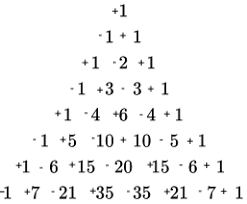Problems
Prove that for all positive integers \(n\) there exists a partition of the set of positive integers \(k\le2^{n+1}\) into sets \(A\) and \(B\) such that \[\sum_{x\in A}x^i=\sum_{x\in B}x^i\] for all integers \(0\le i\le n\).
Find all solutions to \(x^2+2=y^3\) in the natural numbers.
McDonald’s used to sell Chicken McNuggets in boxes of 6, 9 or 20 in the UK before they introduced the Happy Meal. What is the largest number of Chicken McNuggets that could not be bought? For example, you wouldn’t have been able to buy 8 Chicken McNuggets, but you could have bought \(21 = 6+6+9\) Chicken McNuggets.
Show that the equation \(x^4+y^4=z^4\) cannot satisfied by integers \(x,y,z\) if none of them are 0.
In Pascal’s triangle, what are the numbers in the diagonal next to the diagonal of ones?
In Pascal’s triangle, what is the sum of the entries in each row?
Oliver throws a fair coin three times. What are his chances of getting three heads, two heads and one tail, one head and two tails, or three tails?
In Pascal’s triangle, what numbers appear in the diagonal next to the positive integers?
Five friends get together and want to take a photo. They all agree that two of them should take a photo of the other three. How many ways can you choose the three people to be in the picture?
In Pascal’s triangle, what’s the sum of the numbers in each row when you put a minus sign in front of every other number?
